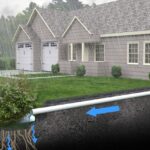When it comes to choosing a roof design for your home, the options can be overwhelming. But among the many roofing styles, the gable roof stands out as a classic, practical choice that offers both aesthetic appeal and functional benefits. In this article, we’ll explore in detail what is a gable roof, and why it’s a favored option for many homeowners.

The Basics of Gable Roofs
A gable roof is one of the most common and simplest forms of roofing styles. It is characterized by its triangular shape, which forms a gable at each end of the house. This style is not just aesthetically pleasing but also offers practical benefits, such as excellent water runoff and space for attic ventilation.
Why Choose a Gable Roof?
Homeowners are often delighted by the simplicity and effectiveness of a gable roof. It’s a design that has stood the test of time around the world. The steep slope ensures that rainwater and snow slide off easily, preventing undue weight and possible structural issues.
Benefits of Gable Roofs
There are several benefits associated with gable roofs, making them a terrific choice for your home. These benefits include:
- Cost-Effectiveness: Generally easier and cheaper to construct due to their simple structure.
- Space Utilization: Gable roofs provide additional space for an attic or vaulted ceilings.
- Ventilation: The design allows for better ventilation options within the attic space.
- Weather Resistance: The shape is excellent for shedding snow and water, reducing maintenance needs.
Types of Gable Roofs
Gable roofs come in several variations, tailored to meet the design and functional needs of the homeowner. Here are a few common types:
Front Gable
A front gable is placed at the front of the house, often used as an entrance. It’s a style that grabs attention and provides a classic look to any home.
Cross Gable
The cross gable style involves two gables that intersect each other at right angles. This configuration adds complexity and is often used in homes with more intricate layouts.
Dutch Gable
This hybrid is a combination of a gable and a hip roof, enhancing aesthetic appeal and providing extra space. It’s particularly useful where additional living space or an attic is desired.
Building Considerations
Building a gable roof requires careful planning and consideration. Here are some key points to keep in mind:
Structural Integrity
Ensure that the design supports your homes structural needs. Consult with a professional to assess load requirements.
Material Choices
Roofing materials play a crucial role in the durability and appearance of your gable roof. Popular choices include asphalt shingles, wood, and metal.
Permits and Codes
In some areas, building codes and permits are necessary to replace or modify a roof. Check with local authorities to ensure compliance before starting construction.
Cost Factors
The cost of building a gable roof can vary based on numerous factors including size, materials, and labor. Generally, the simpler design of a gable roof tends to be more cost-effective than more complex roof styles.
For a detailed breakdown of roofing costs, you might want to explore this roofing cost calculator.
DIY Considerations
While some tasks can be done by homeowners, building or modifying a roof is often best left to professionals to ensure safety and structural integrity.
Maintenance Tips
Maintaining a gable roof is typically straightforward, but regular checks are essential to prolong its lifespan and functionality.
Regular Inspections
Conduct regular visual inspections to spot any loose or damaged shingles. Address issues promptly to prevent water damage.
Gutter Maintenance
Ensure that gutters are clean and functioning properly to facilitate effective water runoff and prevent overflow.
Gable Roof vs Other Roof Types
Comparing gable roofs with other roofing styles, such as hip roofs or flat roofs, can help determine the best choice for your home.
Gable vs Hip Roof
While both designs are popular, gable roofs are generally easier to construct and more economical. Hip roofs, however, offer better stability in high wind areas.
Gable vs Flat Roof
Flat roofs may appeal to modern design aesthetics but require more maintenance for drainage. Gable roofs naturally facilitate water runoff due to their slope.
Conclusion
In conclusion, understanding what is a gable roof and its numerous advantages helps homeowners make informed decisions. Whether you are considering home renovations or designing a new house, a gable roof offers both beauty and practicality. Stay informed, consult professionals, and consider local climate and building codes to ensure your roof meets all your needs.

FAQs
What is the main advantage of a gable roof?
Its steep slope allows for efficient water and snow runoff, reducing the risk of leaks and structural damage.
Are gable roofs good for all climates?
While great for areas with rain and snow, additional bracing may be needed in high wind areas to prevent damage.
Can I build a gable roof by myself?
While possible for small structures, it is advisable to hire professionals for safety and compliance with building codes.
This article contains affiliate links. We may earn a commission at no extra cost to you.








